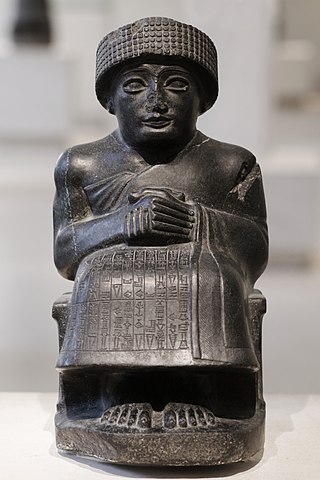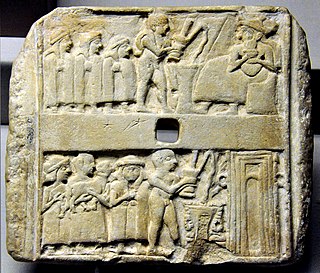
The Sumerian King List or Chronicle of the One Monarchy is an ancient literary composition written in Sumerian that was likely created and redacted to legitimize the claims to power of various city-states and kingdoms in southern Mesopotamia during the late third and early second millennium BC. It does so by repetitively listing Sumerian cities, the kings that ruled there, and the lengths of their reigns. Especially in the early part of the list, these reigns often span thousands of years. In the oldest known version, dated to the Ur III period but probably based on Akkadian source material, the SKL reflected a more linear transition of power from Kish, the first city to receive kingship, to Akkad. In later versions from the Old Babylonian period, the list consisted of a large number of cities between which kingship was transferred, reflecting a more cyclical view of how kingship came to a city, only to be inevitably replaced by the next. In its best-known and best-preserved version, as recorded on the Weld-Blundell Prism, the SKL begins with a number of fictional antediluvian kings, who ruled before a flood swept over the land, after which kingship went to Kish. It ends with a dynasty from Isin, which is well-known from other contemporary sources.

The history of Sumer spans the 5th to 3rd millennia BCE in southern Mesopotamia, and is taken to include the prehistoric Ubaid and Uruk periods. Sumer was the region's earliest known civilization and ended with the downfall of the Third Dynasty of Ur around 2004 BCE. It was followed by a transitional period of Amorite states before the rise of Babylonia in the 18th century BCE.

Uruk, today known as Warka, was an ancient city of Sumer situated east of the present bed of the Euphrates River on the dried-up ancient channel of the Euphrates 30 km (19 mi) east of modern Samawah, Al-Muthannā, Iraq.

Utu, also known under the Akkadian name Shamash, was the ancient Mesopotamian sun god. He was believed to see everything that happened in the world every day, and was therefore responsible for justice and protection of travelers. As a divine judge, he could be associated with the underworld. Additionally, he could serve as the god of divination, typically alongside the weather god Adad. While he was universally regarded as one of the primary gods, he was particularly venerated in Sippar and Larsa.

The Gutian dynasty, was a line of kings, originating among the Gutian people. Originally thought to be a horde that swept in and brought down Akkadian and Sumerian rule in Mesopotamia, the Gutians are now known to have been in the area for at least a century by then. By the end of the Akkadian period, the Sumerian city of Adab was occupied by the Gutians, who made it their capital. The Gutian Dynasty came to power in Mesopotamia near the end of the 3rd Millennium BC, after the decline and fall the Akkadian Empire. How long Gutian kings held rulership over Mesopotamia is uncertain, with estimates ranging from a few years up to a century. The end of the Gutian dynasty is marked by the accession of Uruk ruler Utu-hengal, marking the short lived "Fifth dynasty of Uruk", followed by Ur ruler Ur-Nammu, founder of the Third Dynasty of Ur.

Lugal-Zage-Si of Umma was the last Sumerian king before the conquest of Sumer by Sargon of Akkad and the rise of the Akkadian Empire, and was considered as the only king of the third dynasty of Uruk, according to the Sumerian King List. Initially, as king of Umma, he led the final victory of Umma in the generation-long conflict with the city-state Lagash for the fertile plain of Gu-Edin. Following up on this success, he then united Sumer briefly as a single kingdom.

Lugalbanda was a deified Sumerian king of Uruk who, according to various sources of Mesopotamian literature, was the father of Gilgamesh. Early sources mention his consort Ninsun and his heroic deeds in an expedition to Aratta by King Enmerkar.
Aratta is a land that appears in Sumerian myths surrounding Enmerkar and Lugalbanda, two early and possibly mythical kings of Uruk also mentioned on the Sumerian king list.

Enmerkar was an ancient Sumerian ruler to whom the construction of Uruk and a 420-year reign was attributed. According to literary sources, he led various campaigns against the land of Aratta.

Enmebaragesi (Sumerian: 𒂗𒈨𒁈𒄄𒋛En-me-barag-gi-se [EN-ME-BARA2-GI4-SE]) originally Mebarasi (𒈨𒁈𒋛) was the penultimate king of the first dynasty of Kish and is recorded as having reigned 900 years in the Sumerian King List. Like his son and successor Aga he reigned during a period when Kish had hegemony over Sumer. Enmebaragesi signals a momentous documentary leap from mytho-history to history, since he is the earliest ruler on the king list whose name is attested directly from archaeology.

Tirigan was the 19th and last Gutian ruler in Sumer mentioned on the "Sumerian King List" (SKL). According to the SKL: Tirigan was the successor of Si'um. Tirigan ruled for 40 days before being defeated by Utu-hengal of Uruk, c. 2050 BC.

Hamazi or Khamazi was an ancient kingdom or city-state of some importance that reached its peak c. 2500–2400 BC. Its exact location is unknown, but is thought to have been located in the western Zagros Mountains roughly between Elam and Assyria, possibly near Nuzi or modern Hamadan.

The Guti, also known by the derived exonyms Gutians or Guteans, were a people of the ancient Near East. Their homeland was known as Gutium.

Dumuzid, titled the Fisherman, was a legendary Sumerian king of Uruk listed originating from Kuara. According to legend, in the one-hundredth year of his reign, he was captured by Enmebaragesi.

Anu or Anum, originally An, was the divine personification of the sky, King of the gods, and ancestor of many of the deities in ancient Mesopotamian religion. He was regarded as a source of both divine and human kingship, and opens the enumerations of deities in many Mesopotamian texts. At the same time, his role was largely passive, and he was not commonly worshiped. It is sometimes proposed that the Eanna temple located in Uruk originally belonged to him, rather than Inanna, but while he is well attested as one of its divine inhabitants, there is no evidence that the main deity of the temple ever changed, and Inanna was already associated with it in the earliest sources. After it declined, a new theological system developed in the same city under Seleucid rule, resulting in Anu being redefined as an active deity. As a result he was actively worshiped by inhabitants of the city in the final centuries of history of ancient Mesopotamia.

Sumerian religion was the religion practiced by the people of Sumer, the first literate civilization of ancient Mesopotamia. The Sumerians regarded their divinities as responsible for all matters pertaining to the natural and social orders.
Ur-Ninurta, c. 1859 – 1832 BC or c. 1923 – 1896 BC, was the 6th king of the 1st Dynasty of Isin. A usurper, Ur-Ninurta seized the throne on the fall of Lipit-Ištar and held it until his violent death some 28 years later.

Lugal-kinishe-dudu also Lugal-kiginne-dudu , was a King and (ensi) of Uruk and Ur who lived towards the end of the 25th century BCE. The Sumerian King List mentions Lugal-kinishe-dudu as the second king of the dynasty after En-cakanca-ana, attributing to him a fanciful reign of 120 years.
Ur-nigin, also Ur-nigina or Ur-nigar was a Governor (ensi) of Uruk who lived in 22nd century BCE.
Ur-gigir was the son of Ur-nigin and a Governor (ensi) of Uruk who lived in 22nd century BCE.





























